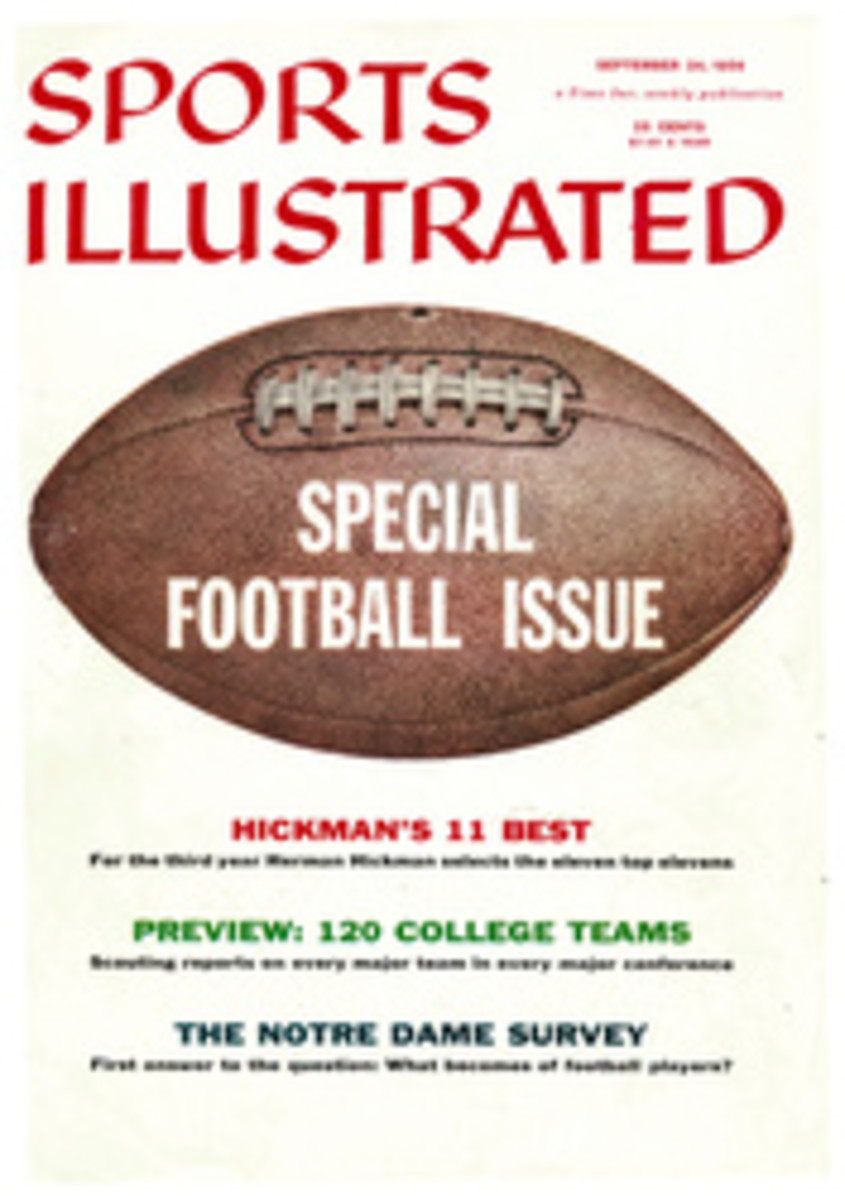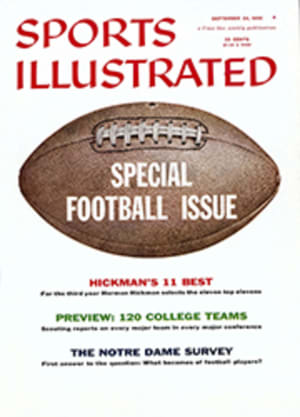
MARCH, MARCH TO VICTORY
It has been hot and dusty in the Southwest, hot and humid in the South, hot and getting hotter in southern California; the leaves have yet to fall, or even turn color in much of New England (though there have been light frosts, praise be, in Minnesota and Iowa), and campuses are just beginning to stir with first arrivals. But the college football season, like one of those exuberant early guests who sweeps into the house while the host is still in the shower and the hostess is shooing children up the back stairs, is here again. This Saturday, time zone by time zone, stadium crowds will roar at the first kickoffs of 1956; the victory celebrations will be under way (opposite page) and after that, no matter the weather, it will be autumn in the U.S.
Technically speaking, college football will be little different from that of '55. The amended rules provide for only two changes of importance—rubber footballs may be used by those who like the idea, and teams which got free time-outs last year by surreptitiously ripping their own breakaway jerseys must suffer a regular time-out to re-equip a player on the field. But tickets will cost a little more in a good many places (from a $1.50 top to $2 at the University of Rhode Island, from $3.50 to $4 at Ohio State, $3.25 to $3.50 in the Southwest Conference) and, as always, the atmosphere in which the game is played and the attitude with which it is received will vary widely from region to region.
In the Northeast and in the Ivy League, football will probably be more casually received by students than ever before—not that they don't enjoy football or don't go to games. "We just don't think of it as a ritualistic orgy," said a New Englander. "You know, Mark Twain once gave a humorous lecture in New England and was horrified at the soberness of his audience. Afterwards an old lady went up to him and said, 'Mr. Twain, I enjoyed that so much that I had all I could do to keep from laughing.' Maybe we feel a little that way about football." But, for all that, the Northeast will go on setting much of the social tone of football: there will be station-wagon picnics, with Martinis before games as usual, and the custom of setting up a big tent for student-graduate lunches at out-of-town games will grow this year. The northeastern schools will also go on setting styles for college football fans.
Bermuda shorts, which invaded the U.S. via the East Coast, will be seen in stadiums in the South, in Texas and in southern California during early, hot-weather games this year. At New England schools like Brown, however, growing new fads will be reflected on football weekends. The Loden coat, with its double row of oblong wooden pegs and connecting crossties, is virtually a "must" for both the Brown men and girls from nearby Pembroke College. Women too are breaking away from colored, rubberized raincoats and going to quieter (and more expensive) poplins. "Sweetheart stadium scarves"—matching scarves for couples—are generally spurned, although 6-foot scarves for women are still standard on a cold afternoon. But many girls who go to Brown games will wear copies of men's tweed sport jackets, and mannish shirts in vertical stripes as well.
There are a lot of other places in the U.S. where college football will be untouched by hypertension. Even in the Midwest, at institutions like Otterbein, Muskingum and Ohio Wesleyan, the opening-day crowds will stand along the sidelines, as of yore, to watch the kickoff. But the regimented uproar of big-time football will ring louder than ever in those great areas of the country where whole populations run a fever on Saturday afternoons.
At Norman (pop. 27,000), Oklahoma, home of Bud Wilkinson's championship Oklahoma Sooners and thus the current capital of a vast sweep of the collegiate Southwest, football is capitalized in every mind; football is important. Big crowds will beat their way to Norman on Saturday this year, not simply, as in the Northeast, to spend a pleasant outdoor afternoon, but to worship vocally at a shrine and die a thousand deaths if the score is wrong when Oklahoma's red-and-white-clad warriors leave the turf at Owen Field—turf which has been so watered, so tenderly nurtured that it seems like a blazing green oasis set down in the drought-browned countryside. There will be 55,000 people in Norman for the opening game with North Carolina; they will come in chartered buses after pregame luncheons at Oklahoma City; in special trains, in cars, in dozens of personal and company airplanes. When Oklahoma travels, an astonishing number of the faithful will go too—7,500 tickets for this year's O.U.-Notre Dame game at South Bend, Ind. were sold only four days after they went on sale last April 5.
In the seats of the mighty, too, the pursuit of bodies suitable for varsity combat went on right up to the sill of the registrar's office. The University of Mississippi, for instance, prepared for 1956, confident that it had successfully won the affections and services of one of the South's hottest prep stars—a husky young Vicksburg halfback named Claude King. But though Claude had a football scholarship at Ole Miss, he was offered and accepted a better deal with the University of Houston and headed for Texas. Ole Miss threatened to cancel all future games with the Texas school only to hear that Claude was thinking of moving on to Seattle to play for the University of Washington.
Direct action seemed the only answer. Last week a Mississippi coach invaded Houston by automobile, grabbed the halfback, and whisked him back to his home state. But his parents, in turn, drove to the Ole Miss campus and dragged him back to Vicksburg. And there he sat as of last weekend. "He will have the freedom of his home," said his mother angrily, "in making his final decision."
There were evidences of budding big-time football excitement in a lot of other places too.
Michigan has built a half-million dollar press box atop its stadium since last year, and Michigan State had its band director, Leonard Falcone, on the road all summer rounding up tuba and fife players (there being no Big Ten rules against the recruitment of bandsmen). UCLA plans new card stunts which will be "bigger and more full of motion than ever." In its opening game against Utah (to be held at night to avoid frying both teams and spectators under the southern sun) UCLA students will use colored flashlights and be synchronized to a sound tape. The display will be concerned with the Pacific Coast Conference scandal over subsidization, and the final stunt will show a character named Max Martian who has been sentenced to three years of "suspended animation," peering through bars labeled PCC. "We think," says the UCLA rally chairman, Mike Wolfson, "that the crowd will get it."
But, north, south, east, and west, the first crash of band music, the first sustained roar from the packed stadiums will herald again a wonderful time of the year. No sport flavors its season quite as much as college football; for all its difficulties and all its commercialism, it is a symbol of romance to Americans and they cannot sit in stadiums (or listen to a game broadcast or watch one on television) without a reaction, somewhere in their souls, to its legends; to something compounded of Stover at Yale, the prose of F. Scott Fitzgerald, the half-forgotten memories of George Gipp and Brick Muller and Jim Thorpe, of Centre College on its day of glory, and all the storied halfbacks who won the game and the girl and lived happily ever after.
[originallink:10470991:42357]
ILLUSTRATION
PHOTO
MARVIN NEWMAN
PHOTO
MARVIN NEWMAN
Victory shoulder ride for star (Eagle Day) and coach (Johnny Vaught) is a bowl must. Winning Rebels Charles Burke (84), Jerry McKaskel (35), Earl Blair (22), Gayle Bowman (20) join in the celebration
PHOTO
MARVIN NEWMAN
Linemen Buddy Alliston (mask), Gene Dubuisson finally share credit with Back Gayle Bowman
THE RITES OF VICTORY
The celebration of the football triumph is as stylized as that of the bullfight, and nowhere more so than at the New Year's Day bowl games such as that at Dallas' Cotton Bowl, shown on the next four pages. The halfback is bussed by a pretty cheerleader, who may even—as in the case of Mississippi's Billy Kinard (opposite)—be his wife, and the sweaty linemen emerge from their anonymity to exchange congratulations and hearty handshakes. Finally, the coach and star are carried off by the proud and happy fans and players into the uproar of the dressing room.

